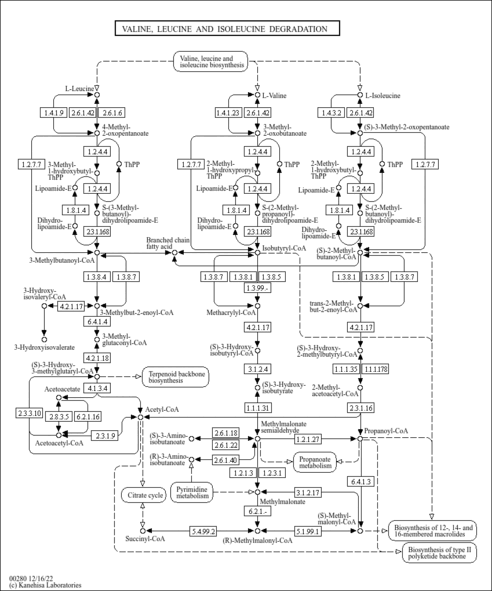| Record Information |
|---|
| Version | 5.0 |
|---|
| Status | Expected but not Quantified |
|---|
| Creation Date | 2005-11-16 15:48:42 UTC |
|---|
| Update Date | 2022-03-07 02:49:08 UTC |
|---|
| HMDB ID | HMDB0001041 |
|---|
| Secondary Accession Numbers | - HMDB0002021
- HMDB0002191
- HMDB0002253
- HMDB0060317
- HMDB01041
- HMDB02021
- HMDB02191
- HMDB02253
- HMDB60317
|
|---|
| Metabolite Identification |
|---|
| Common Name | 2-Methylbutyryl-CoA |
|---|
| Description | 2-Methylbutyryl-CoA (CAS: 6712-02-3), also known as alpha-methylbutyryl-coenzyme A, belongs to the class of organic compounds known as acyl-CoAs. These are organic compounds containing a coenzyme A substructure linked to an acyl chain. 2-Methylbutyryl-CoA is a strong basic compound (based on its pKa). 2-Methylbutyryl-CoA is a product of isoleucine catabolism. It is converted into tiglyl-CoA by short/branched-chain acyl-CoA dehydrogenase. 2-Methylbutyryl-CoA dehydrogenase deficiency, also known as 2-methyl-3-hydroxybutyryl-CoA dehydrogenase deficiency or MBHD, is an inherited disorder in which the body is unable to process the amino acid isoleucine properly. It is caused by a mutation in the HADH2 gene. Untreated MBHD can lead to progressive loss of motor skills, mental retardation, and epilepsy. |
|---|
| Structure | CC[C@H](C)C(=O)SCCNC(=O)CCNC(=O)[C@H](O)C(C)(C)COP(O)(=O)OP(O)(=O)OC[C@H]1O[C@H]([C@H](O)[C@@H]1OP(O)(O)=O)N1C=NC2=C1N=CN=C2N InChI=1S/C26H44N7O17P3S/c1-5-14(2)25(38)54-9-8-28-16(34)6-7-29-23(37)20(36)26(3,4)11-47-53(44,45)50-52(42,43)46-10-15-19(49-51(39,40)41)18(35)24(48-15)33-13-32-17-21(27)30-12-31-22(17)33/h12-15,18-20,24,35-36H,5-11H2,1-4H3,(H,28,34)(H,29,37)(H,42,43)(H,44,45)(H2,27,30,31)(H2,39,40,41)/t14-,15+,18+,19+,20-,24+/m0/s1 |
|---|
| Synonyms | | Value | Source |
|---|
| (S)-2-Methylbutanoyl-coenzyme A | ChEBI | | (S)-2-Methylbutyryl-CoA | ChEBI | | (S)-2-Methylbutyryl-coenzyme A | ChEBI | | 2-Methylbutyryl CoA | HMDB | | 2-Methylbutyryl-CoA | HMDB | | 2-Methylbutyryl-coenzyme A | HMDB | | alpha-Methylbutyryl CoA | HMDB | | alpha-Methylbutyryl coenzyme A | HMDB | | α-Methylbutyryl CoA | HMDB | | α-Methylbutyryl coenzyme A | HMDB |
|
|---|
| Chemical Formula | C26H44N7O17P3S |
|---|
| Average Molecular Weight | 851.651 |
|---|
| Monoisotopic Molecular Weight | 851.172723243 |
|---|
| IUPAC Name | {[(2R,3S,4R,5R)-5-(6-amino-9H-purin-9-yl)-4-hydroxy-2-({[hydroxy({hydroxy[(3R)-3-hydroxy-2,2-dimethyl-3-({2-[(2-{[(2S)-2-methylbutanoyl]sulfanyl}ethyl)carbamoyl]ethyl}carbamoyl)propoxy]phosphoryl}oxy)phosphoryl]oxy}methyl)oxolan-3-yl]oxy}phosphonic acid |
|---|
| Traditional Name | [(2R,3S,4R,5R)-5-(6-aminopurin-9-yl)-4-hydroxy-2-({[hydroxy([hydroxy((3R)-3-hydroxy-2,2-dimethyl-3-({2-[(2-{[(2S)-2-methylbutanoyl]sulfanyl}ethyl)carbamoyl]ethyl}carbamoyl)propoxy)phosphoryl]oxy)phosphoryl]oxy}methyl)oxolan-3-yl]oxyphosphonic acid |
|---|
| CAS Registry Number | 87069-91-8 |
|---|
| SMILES | CC[C@H](C)C(=O)SCCNC(=O)CCNC(=O)[C@H](O)C(C)(C)COP(O)(=O)OP(O)(=O)OC[C@H]1O[C@H]([C@H](O)[C@@H]1OP(O)(O)=O)N1C=NC2=C1N=CN=C2N |
|---|
| InChI Identifier | InChI=1S/C26H44N7O17P3S/c1-5-14(2)25(38)54-9-8-28-16(34)6-7-29-23(37)20(36)26(3,4)11-47-53(44,45)50-52(42,43)46-10-15-19(49-51(39,40)41)18(35)24(48-15)33-13-32-17-21(27)30-12-31-22(17)33/h12-15,18-20,24,35-36H,5-11H2,1-4H3,(H,28,34)(H,29,37)(H,42,43)(H,44,45)(H2,27,30,31)(H2,39,40,41)/t14-,15+,18+,19+,20-,24+/m0/s1 |
|---|
| InChI Key | LYNVNYDEQMMNMZ-JRQZLUQRSA-N |
|---|
| Chemical Taxonomy |
|---|
| Description | Belongs to the class of organic compounds known as acyl coas. These are organic compounds containing a coenzyme A substructure linked to an acyl chain. |
|---|
| Kingdom | Organic compounds |
|---|
| Super Class | Lipids and lipid-like molecules |
|---|
| Class | Fatty Acyls |
|---|
| Sub Class | Fatty acyl thioesters |
|---|
| Direct Parent | Acyl CoAs |
|---|
| Alternative Parents | |
|---|
| Substituents | - Coenzyme a or derivatives
- Purine ribonucleoside 3',5'-bisphosphate
- Purine ribonucleoside bisphosphate
- Purine ribonucleoside diphosphate
- Ribonucleoside 3'-phosphate
- Pentose phosphate
- Pentose-5-phosphate
- Beta amino acid or derivatives
- Glycosyl compound
- N-glycosyl compound
- 6-aminopurine
- Monosaccharide phosphate
- Organic pyrophosphate
- Pentose monosaccharide
- Imidazopyrimidine
- Purine
- Monoalkyl phosphate
- Aminopyrimidine
- Imidolactam
- N-acyl-amine
- N-substituted imidazole
- Organic phosphoric acid derivative
- Monosaccharide
- Pyrimidine
- Alkyl phosphate
- Fatty amide
- Phosphoric acid ester
- Tetrahydrofuran
- Imidazole
- Azole
- Heteroaromatic compound
- Carbothioic s-ester
- Secondary alcohol
- Thiocarboxylic acid ester
- Carboxamide group
- Secondary carboxylic acid amide
- Amino acid or derivatives
- Sulfenyl compound
- Thiocarboxylic acid or derivatives
- Organoheterocyclic compound
- Azacycle
- Oxacycle
- Carboxylic acid derivative
- Organosulfur compound
- Organic oxygen compound
- Hydrocarbon derivative
- Carbonyl group
- Organic nitrogen compound
- Primary amine
- Organopnictogen compound
- Organic oxide
- Organooxygen compound
- Organonitrogen compound
- Alcohol
- Amine
- Aromatic heteropolycyclic compound
|
|---|
| Molecular Framework | Aromatic heteropolycyclic compounds |
|---|
| External Descriptors | Not Available |
|---|
| Ontology |
|---|
| Physiological effect | Not Available |
|---|
| Disposition | |
|---|
| Process | |
|---|
| Role | |
|---|
| Physical Properties |
|---|
| State | Solid |
|---|
| Experimental Molecular Properties | | Property | Value | Reference |
|---|
| Melting Point | Not Available | Not Available | | Boiling Point | Not Available | Not Available | | Water Solubility | Not Available | Not Available | | LogP | Not Available | Not Available |
|
|---|
| Experimental Chromatographic Properties | Not Available |
|---|
| Predicted Molecular Properties | |
|---|
| Predicted Chromatographic Properties | Predicted Collision Cross SectionsPredicted Kovats Retention IndicesUnderivatized |
|---|
